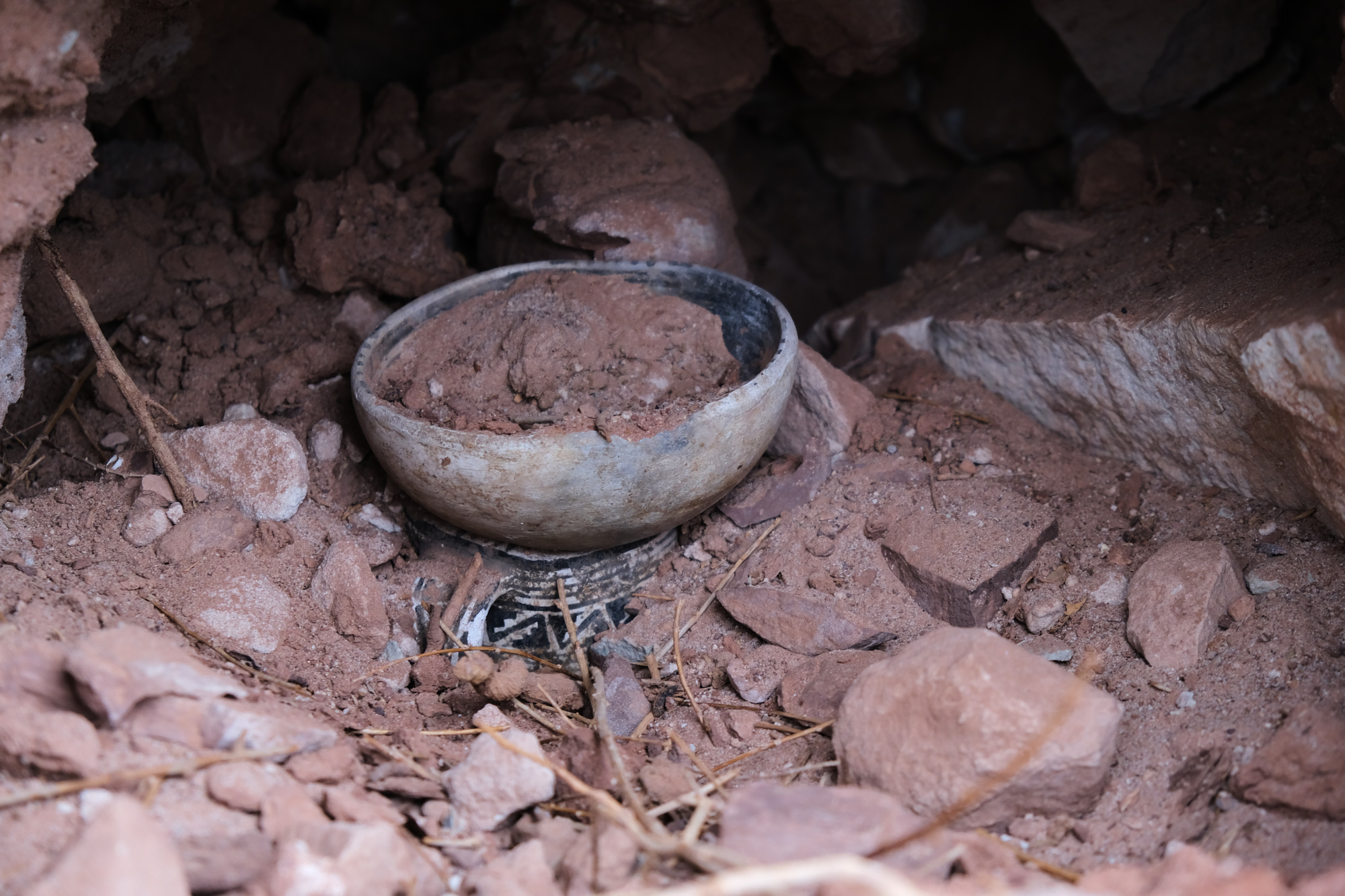
To be honest, I was a disappointed. I’d just finished showing my pottery find to the curator and director of the Edge of the Cedars State Park Museum, which has the largest collection of Ancestral Puebloan (Anasazi) pottery on display in the Four Corners Region. After inspecting the pottery and taking pictures, we’d replaced the sticks and twigs covering it, climbed back down and were standing by our trucks making chitchat about the archeology in the area. I started to wonder if maybe my discovery wasn’t very unique. I decided I’d be more direct. “How important of a find would you say this is, on scale of 1-10?” I asked, probing a bit. He paused briefly before saying, “I’d say this is a 13 or 14.” OK. It was pretty special.
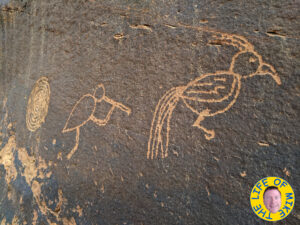
Rock art near camp
Two days prior I was just wrapping up a couple weeks of camping in the wilderness. My goal was to find, photograph and explore some ancient cliff dwellings and rock art. This area of the Southwest is covered in ancient sites so I didn’t have to look too hard to find some amazing history. I was literally on my way home when I decided to make one last stop to check out a couple of rock art sites I’d read about, but never seen.
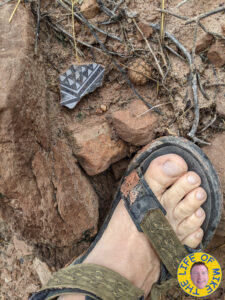
Black on grey pottery sherd
As I climbed up a steep hill to the rock art sites I noticed a large amount of pottery sherds (yep sherds, not shards) on the loose hillside. That wasn’t a total surprise as people had been in this area for thousands of years. There were reminders of their presence everywhere, especially if you paid attention and looked hard enough. But in this spot, I felt something stronger. I can’t really explain it other than to say it felt like I wasn’t alone.
So after I’d taken a few pictures of the rock art I decided to scan the cliff face above for more rock art or structures. I pulled out my binoculars and noticed a panel with some unusual symbols I’d never seen before and decided to check it out. As I scrambled up the hill I looked in every nook and crany, hoping to find some hidden treasure. I’d done this for over 20 years in this region and never found anything interesting, but that was about to change.
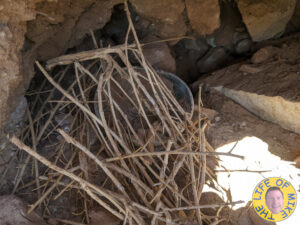
How it looked when I found it
As I passed by one opening, I noticed some twigs and dry grass inside. I thought that was odd, because there weren’t any bushes or grass growing anywhere on the hill. But there was some vegitation at the bottom of the hill and desert rodents always build their nests in small cracks or voids, so maybe that’s all this was. Then I looked closer and saw something that didn’t fit. I moved the twigs and grass aside and there sat a completely intact piece of ancient pottery.
I couldn’t believe it. I have literally looked in thousands of openings over the years and never saw anything. And here in front of me was a piece of pottery that had to be hundreds of years old. I was stunned. My heart started racing and I looked around to see if anyone was watching me. I was alone, but that might change so I kicked into high gear. I had read many articles and books on archaeology and the one thing they always say is to not move anything and document the find. So I quickly took a few photos, replaced the twigs and grass that were hiding this incredible piece of history, and climbed down to my truck.
I knew I had to tell someone about my find, but I didn’t know who. I jumped online and found the Utah State Historic Preservation Office (USHPO). Their mission is to help protect the incredible history in their state. I found the head of the office, who happened to be an archaeologist, and gave him a call. There was no answer so I sent him an email. I found another archaeologist that was an employed of USHPO and sent her an email too. But i couldn’t wait. I was too excited so I decided to check with federal offices.
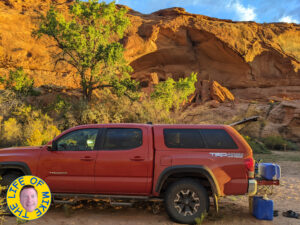
Camp along the river
I wasn’t sure if I was on State or Federal land, but I figured whomever I talked to could help me figure it out. I looked up the nearest Bureau of Land Management (BLM) office, which I’d coincidentally been to earlier in my trip to get some maps and recommendations on where to go to view some archaeological sites. I sent them an email too. Now there was nothing left to do but wait. I decided to postpone my return home to see how this all turned out.
I needed a place to stay, and there was another site in the area with great rock art that I’d read about but hadn’t visited yet. So I headed back out into the wilderness for another night. After exploring these incredible sites I set up camp, fired up my satellite Internet and anxiously checked my messages. There were emails and voicemails from both the USHPO and BLM. As it turned out, they were pretty excited too. I sent them a few photos which seemed to get them even more exited. There wasn’t someone from the office in the immediate area, but the curator of the Edge of the Cedars pottery museum was willing to meet me the following afternoon. And the morning after that, several archaeologists from the BLM were able to meet. This was getting exciting.
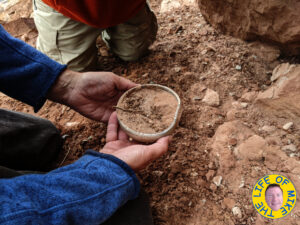
The ladle bowl
In the morning I got up and four-wheeled out of the wilderness and checked into a hotel. I met the curator and his boss at a nearby shop and we headed over to the site. We climbed up the hill and I led them to the place I’d made my discovery just the day before. I pointed to place where the pottery was located. The curator knelt down, took a couple photos and then reached in and pulled out a bowl. To be more exact, it was a ladle, but the handle had broken off in antiquity and someone had reworked the surface and repurposed it as a bowl. It was in perfect condition, but what came next was even more astounding.
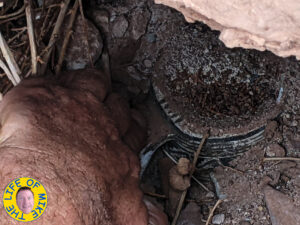
The mug below the bowl
Buried in the dirt up to the top of its handle was a mug. Its decorative painting black and white painting was clearly visible and the curator quickly identified it as a Mesa Verde style mug. These mugs were only made from about 1000 to 1150. They were not made before or after. So that definitely dated my find to approximately 1,000 years old. Yes, you read that right. (See Things that happened AFTER this pottery was made below) I had not only found intact 1,000 year old pottery, I had found two unique pieces of 1,000 year old pottery! Defintely a 13 or 14 on a scale of 1 to 10. I was absolutely blown away.
Later that night I got a couple emails from the second person I had contacted in the USHPO. She said that since I had been in contact with her boss, she would bow out of the conversation. I thanked her for her call but wanted to get her opinion on the rarity of the find. I asked her the same think I’d asked the curator. She said she couldn’t put a number on it but said it is exceedingly rare. In fact, she said most archaeologist will never have a find like this in their entire careers. She said she had been an archaeologist for more than 25 years and had never found anything like I had. “You are justified in taking a victory lap,” she said. Again, I was incredibly humbled by my good fortune.
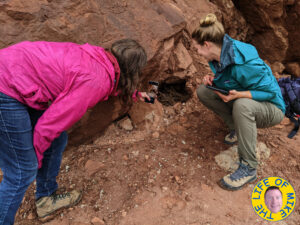
BLM Archaeologists Documenting
The next morning I met the archaeologists from the BLM. They were three young women that were as excited as I was to see these antiquities in situ. We climbed the hill and I pointed to the opening. Their eyes and smiles widened as they gazed at pieces of pottery that had been hidden from daylight for over ten centuries. After documenting the pottery, they also documented the surrounding area. They let me join them as they took photos and GPS coordinates of every pottery sherd on the hillside and mapped out the history. They also found an old granary with ancient corncobs present that I had walked right past and not even noticed. The hill was alive with history and I enjoyed every second of the process of documentation. They even named the survey after me because the area had not been previously documented. Incredible!
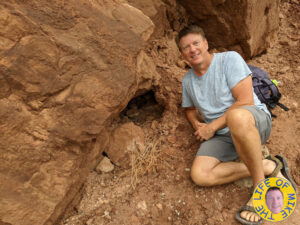
My archaeology find of a lifetime
That night I reflected on how a 2 decades long passion for archaeology had been rewarded with an incredible find. I don’t have words to describe how I felt. There were even times when I was overcome by emotion. I still have a hard time comprehending the magnitude of my discovery. Will it change the world? Of course not, but it has changed my life. I’ll never be able to look out over that land of the ancients without remembering the moment I looked into that opening and saw those items that were left there by someone so long ago.
Final Note: Some might wonder why I didn’t take the bowl and mug. First of all, these are cultural treasures that need to respected. And what was I going to do with them? Put some potpourri in the bowl and put it on my kitchen counter? Drink my morning coffee out of the mug? Hell no! Secondly, under The Archaeological Resources Protection Act of 1979 it’s a federal crime punishable with up to a $100,000 fine and 5 years in prison for repeat offenders. These items deserve to either be left where they have been for the last thousand years, or if the nations decide to excavate, they should be displayed in a museum for many people to see for a long time. I was just a tiny blip in the journey of these treasures. They have a greater story to tell.
Things that happened AFTER this pottery was made
- 1110 – 1150 – Ankor Wat is built in the Khmer Kingdom, present day Cambodia
- 1145– 1148 – The Second Crusade is launched
- 1163 – Work Began On Notre Dame
- 1199 – Richard The Lionhearted Dies
- 1200 – The Toltec Empire collapses
- 1204 – Fourth Crusade sacks Byzantine Constantinople and creates the Latin Empire
- 1206 – Mongols united under Temujin, who is proclaimed “Genghis Khan”
- 1215 – King John of England forced to sign Magna Carta at Runnymede
- 1227 – Genghis Khan dies
- 1244 – The Itzá abandon Chichén Itzá
- 1271 – Marco Polo reaches China
- 1337 – Start of the Hundred Year War
- 1347 – 1353 – The Black Death- The Black Death (bubonic plague) spreads throughout Europe
- 1438 – Inca Dynasty Founded
UPDATE!!! – Monday, March 13, 2023:
I just heard back from the archaeologist of the US Government’s Beureau of Land Management (BLM). She said, and I quote:
“We have wrapped up consultation and have a couple of visits planned with tribal members to the area. At the request of the tribal nations, the pottery will be stabilized near where you found it rather than collected for storage at a museum.”
I think this is a great outcome. The pottery can stay where it’s been for the last 10 centuries. And when I’m in the area in the future, I can look up and know that I have a little secret up there in the cliffs.
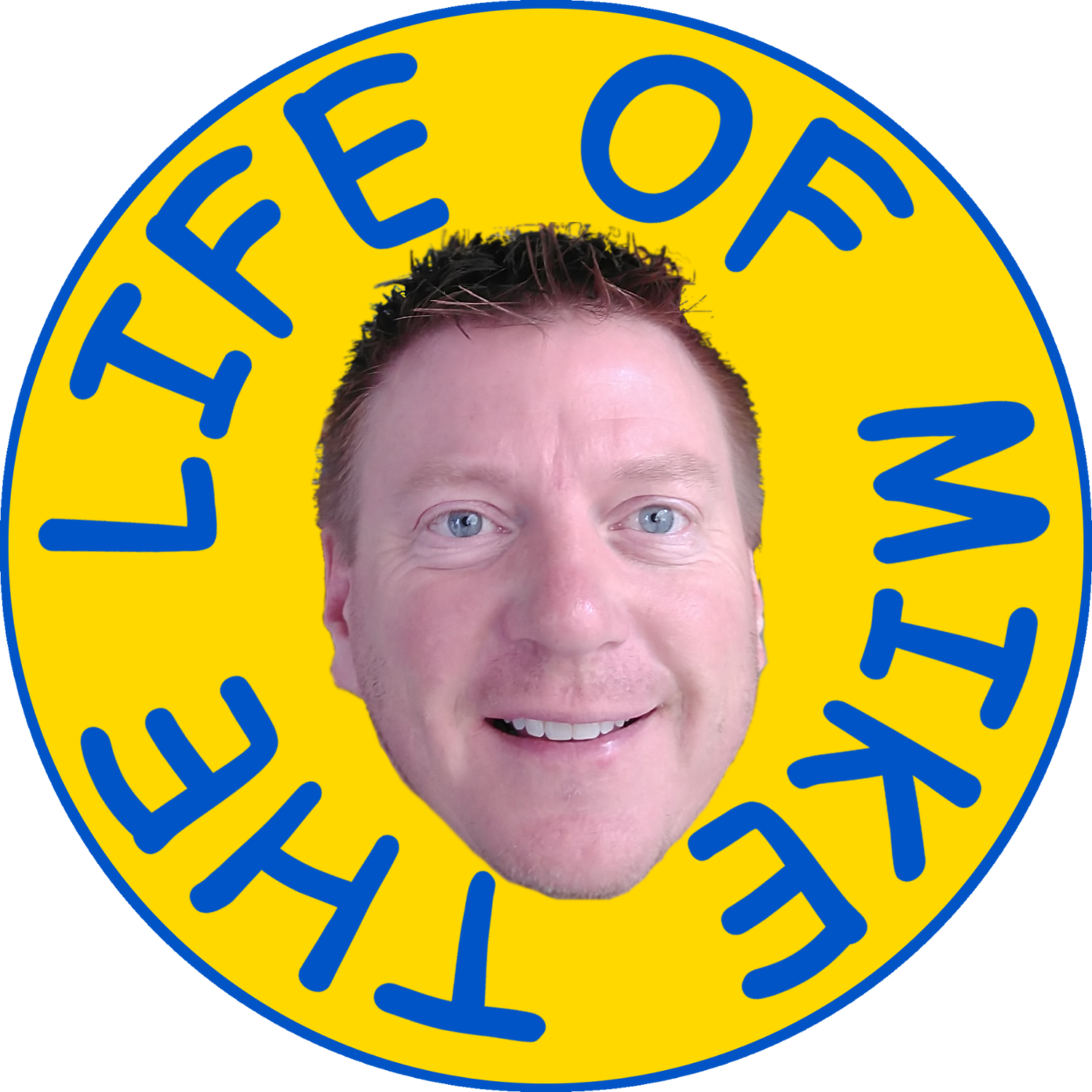
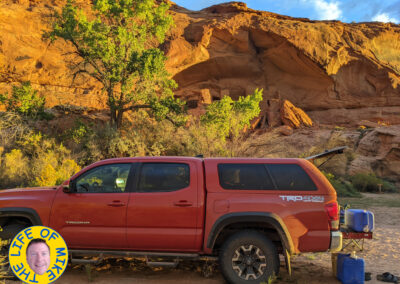
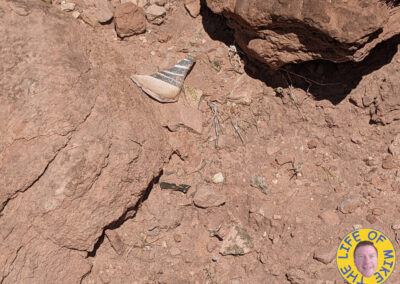
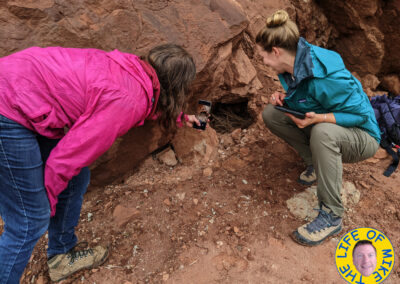
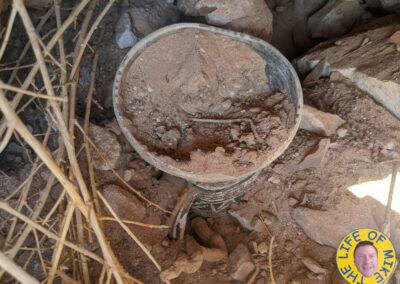
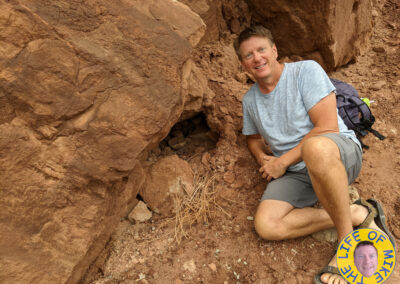


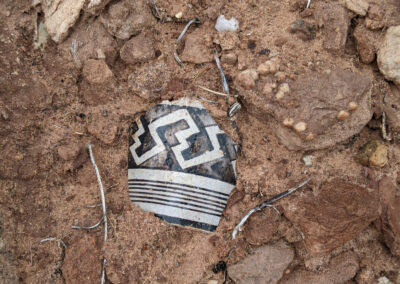
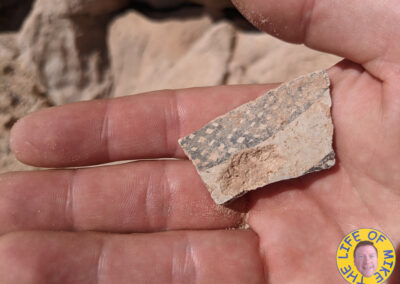
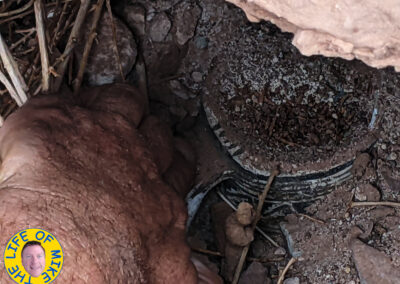
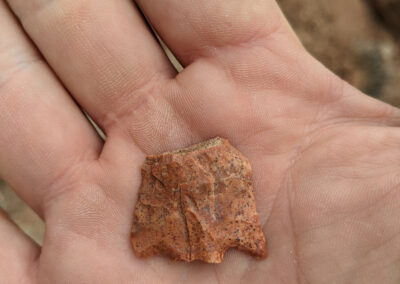
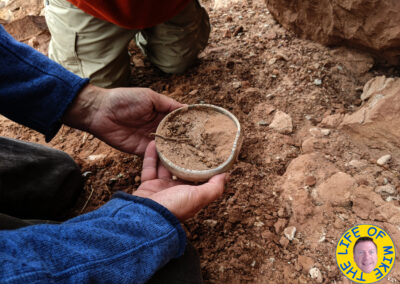
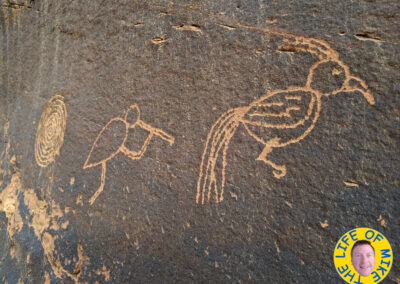
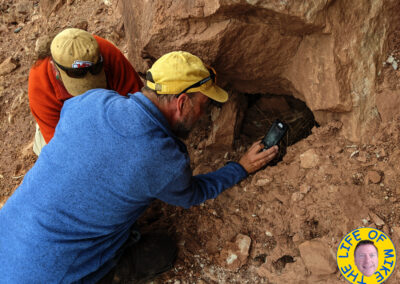
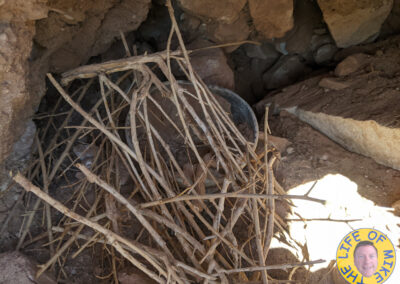

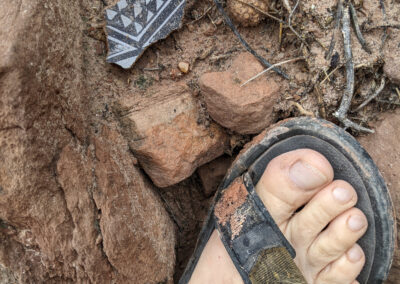
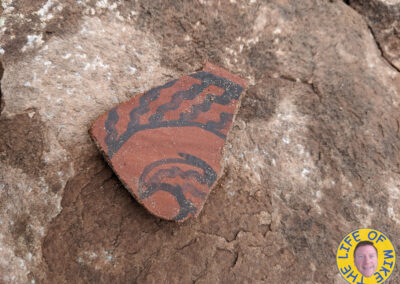
Recent Comments